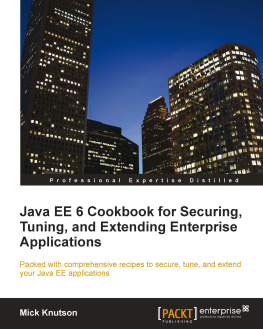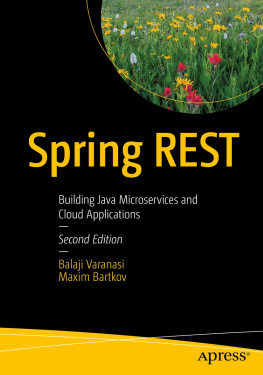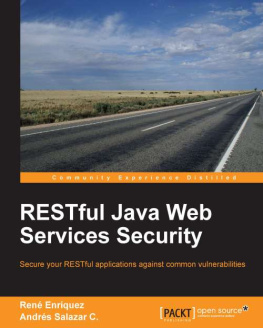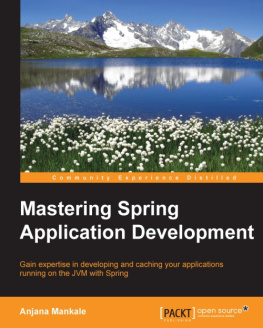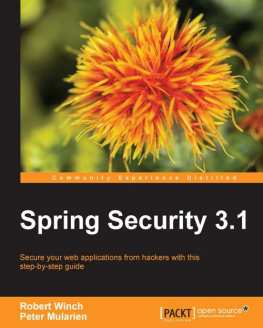Mick Knutson - Spring Security
Here you can read online Mick Knutson - Spring Security full text of the book (entire story) in english for free. Download pdf and epub, get meaning, cover and reviews about this ebook. year: 2017, publisher: Packt Publishing, genre: Computer. Description of the work, (preface) as well as reviews are available. Best literature library LitArk.com created for fans of good reading and offers a wide selection of genres:
Romance novel
Science fiction
Adventure
Detective
Science
History
Home and family
Prose
Art
Politics
Computer
Non-fiction
Religion
Business
Children
Humor
Choose a favorite category and find really read worthwhile books. Enjoy immersion in the world of imagination, feel the emotions of the characters or learn something new for yourself, make an fascinating discovery.
- Book:Spring Security
- Author:
- Publisher:Packt Publishing
- Genre:
- Year:2017
- Rating:5 / 5
- Favourites:Add to favourites
- Your mark:
Spring Security: summary, description and annotation
We offer to read an annotation, description, summary or preface (depends on what the author of the book "Spring Security" wrote himself). If you haven't found the necessary information about the book — write in the comments, we will try to find it.
Learn how to secure your Java applications from hackers using Spring Security 4.2
About This Book- Architect solutions that leverage the full power of Spring Security while remaining loosely coupled.
- Implement various scenarios such as supporting existing user stores, user sign up, authentication, and supporting AJAX requests,
- Integrate with popular Microservice and Cloud services such as Zookeeper, Eureka, and Consul, along with advanced techniques, including OAuth, JSON Web Tokens (JWS), Hashing, and encryption algorithms
This book is intended for Java Web and/or RESTful webservice developers and assumes a basic understanding of creating Java 8, Java Web and/or RESTful webservice applications, XML, and the Spring Framework. You are not expected to have any previous experience with Spring Security.
What You Will Learn- Understand common security vulnerabilities and how to resolve them
- Learn to perform initial penetration testing to uncover common security vulnerabilities
- Implement authentication and authorization
- Learn to utilize existing corporate infrastructure such as LDAP, Active Directory, Kerberos, CAS, OpenID, and OAuth
- Integrate with popular frameworks such as Spring, Spring-Boot, Spring-Data, JSF, Vaaden, jQuery, and AngularJS.
- Gain deep understanding of the security challenges with RESTful webservices and microservice architectures
- Integrate Spring with other security infrastructure components like LDAP, Apache Directory server and SAML
Knowing that experienced hackers are itching to test your skills makes security one of the most difficult and high-pressured concerns of creating an application. The complexity of properly securing an application is compounded when you must also integrate this factor with existing code, new technologies, and other frameworks. Use this book to easily secure your Java application with the tried and trusted Spring Security framework, a powerful and highly customizable authentication and access-control framework.
The book starts by integrating a variety of authentication mechanisms. It then demonstrates how to properly restrict access to your application. It also covers tips on integrating with some of the more popular web frameworks. An example of how Spring Security defends against session fixation, moves into concurrency control, and how you can utilize session management for administrative functions is also included.
It concludes with advanced security scenarios for RESTful webservices and microservices, detailing the issues surrounding stateless authentication, and demonstrates a concise, step-by-step approach to solving those issues. And, by the end of the book, readers can rest assured that integrating version 4.2 of Spring Security will be a seamless endeavor from start to finish.
Style and approachThis practical step-by-step tutorial has plenty of example code coupled with the necessary screenshots and clear narration so that grasping content is made easier and quicker.
Mick Knutson: author's other books
Who wrote Spring Security? Find out the surname, the name of the author of the book and a list of all author's works by series.


